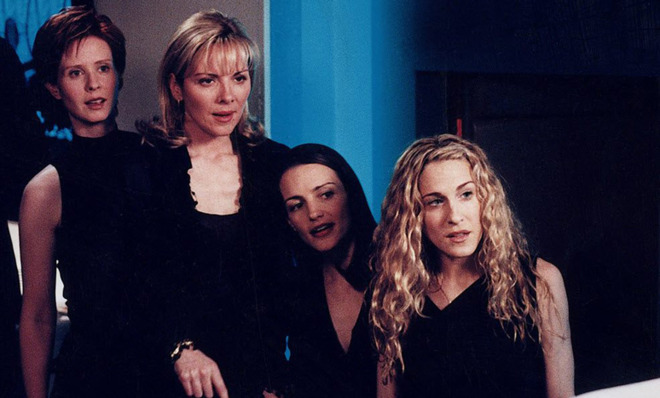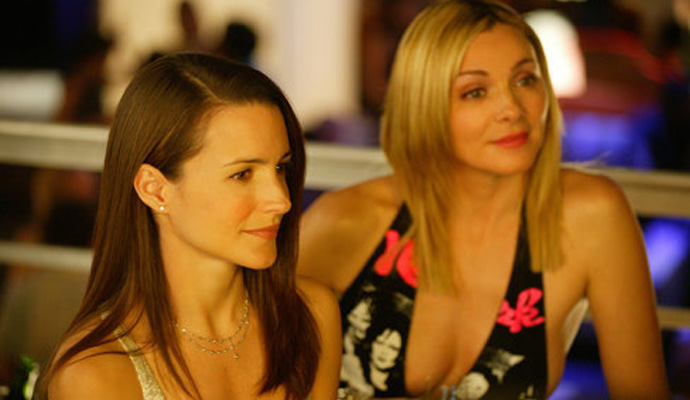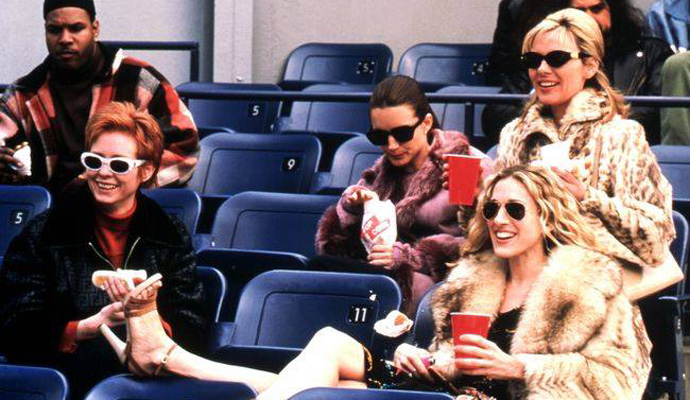Girls on Film: The forgotten legacy of Sex and the City
Ten years ago, we said goodbye. A lot has changed since.


"The most exciting, challenging, and significant relationship of all is the one you have with yourself," Carrie Bradshaw declared 10 years ago at the end of Sex and the City's television run. Sarah Jessica Parker's fashion-centric writer got her happy ending — a castle in the guise of Paris, and a prince in the shoes of Aleksander Petrovsky… and discovered that a happy ending centered solely on romance was terrifically flawed.
Mr. Big traversed the ocean to save her, and Carrie found a different happy ending. She had her home, her writing, her friends, and finally, Big's heart. But with the arrival of two films, Carrie's happy ending — imperfect, but certainly better than the rom-com status quo — was retroactively rendered just as phony as the flawed Paris fantasy it originally replaced. Happiness, the films seemed to argue, wasn't about the self after all; it was shoes and drinks and dresses filtered through a thick layer of American exceptionalism.
The two Sex and the City movies tarnished the legacy of the show so thoroughly that by 2013, Sex and the City barely merited mention in discussions of the rise of HBO's series and the golden age of television until Emily Nussbaum countered such narrow memories in The New Yorker. "As The Sopranos has ascended to TV's Mt. Olympus," she wrote, "the reputation of Sex and the City has shrunk and faded, like some tragic dry-clean-only dress tossed into a decade-long hot cycle." Remember, Nussbaum wrote, that Sex and the City was "once one of HBO's flagship shows … a bold riff on the romantic comedy" that held more depth than its fashion-obsessed legacy suggested.
The Week
Escape your echo chamber. Get the facts behind the news, plus analysis from multiple perspectives.

Sign up for The Week's Free Newsletters
From our morning news briefing to a weekly Good News Newsletter, get the best of The Week delivered directly to your inbox.
From our morning news briefing to a weekly Good News Newsletter, get the best of The Week delivered directly to your inbox.
So what's the true legacy of Sex and the City? Let's take a walk through the show's history and see what happened along the way.
***
Sex and the City began, as it ended, with a fish-out-of-water fairy tale that starts with "once upon a time."
Carrie began as a cultural anthropologist of Manhattan, secondary to the stories she relayed. She came into focus only after other women’s insights and experiences were established, with the production’s gritty 16mm film giving the show a relatable and grounded documentarian vibe. Carrie catalogued life in the city, using her own experiences as a jumping-off point to gain other women's perspectives. An embarrassing interlude with a friend's husband led to an investigation of singles versus couples; a horribly embarrassing cover photo allowed her to look at how women are questioned in society.
A free daily email with the biggest news stories of the day – and the best features from TheWeek.com
Sex and the City helped foster an unabashedly feminine form of television — not an explosion of pink and proper, but a gauntlet of estrogen exploring every manifestation of womanhood. And especially sex; we learned that "Miranda's sexuality was overwhelming poor Skipper," and the innocent Charlotte became a gateway into sexual scenarios that included oral, anal, manual, circumcision, threesomes, and even foot fetishists.

For once, women were the ones having loud and unapologetic conversations about sex. This female focus extended behind the scenes, too. A man, Darren Star, is the credited creator of the series, but the first season was heavily lifted from Candace Bushnell's source material, and was adapted with the collaboration of female writers and directors. The first five episodes were all directed by women.
As a fundamentally femme-centric series, Sex and the City began by questioning the status quo. "How fun will all-night club-hopping be at 40?" a magazine asks when it puts a sleep-deprived picture of Carrie on its cover. She and her friends subsequently revolt; they refuse to apologize for their success, their sexuality, and their choices. That doesn't mean that Carrie and her cohorts wanted the same things; some were looking for commitment and family, others were not. By exploring many Manhattanites, Carrie allowed for womanhood to be defined by more than marriage and motherhood, and by more than her friends' narrow experiences.
***
Like many successful TV shows, melodrama eventually crept in, killing context in favor of a voyeuristic soap opera format. As Sex and the City went on, the cultural anthropologist became the self-obsessed writer. Carrie gave up interviewing Manhattanites to focus on her small group and their personal obsessions. The drama that enveloped the show ultimately pushed Carrie and her friends into the cultural norms they once resisted — more untouchable female archetypes concerned with love, family, fashion, and age.
The women of Sex and the City were always privileged, but under the spotlight of success and marketing magic, the show slowly gave up some relatability in favor of a very specific type of wish fulfillment. Gradually, the ladies stopped donning sweats and denim for quiet nights in with each other where they ate takeout on the floor and played poker for a few extra bucks. The privileged perk became the everyday norm; fashion became a constant presence as the ladies donned colorful, highly fashionable attire for everything from casual baseball outings to bar openings and morning brunch. Each step took them toward a television ideal and away from the everywoman.
The post-9/11 world didn't really exist for these women. The towers were quietly taken out of the show's introduction when the show returned from a break in 2002, and economic woes were mentioned briefly before greater fortune descended. Carrie might finally realized that her $750 rent was unfathomably lucky — but just as she faced $3,000 rent, she'd get the money to buy her place, earn an astronomical $4.50 a word at Vogue, and nab a book deal to keep her in her fancy Manolo Blahniks.

The sex, meanwhile, slowly became secondary to the relationships. Charlotte got married to achieve her vision of the ideal marriage (and later got divorced, finding perfection in the imperfect Harry). Miranda got pregnant, learned to compromise, and married her laid-back love, Steve. Samantha hunted for the perfect combination of sex and romance with Richard and Smith. Carrie chose one bad boyfriend after another until Big finally got over his fear and learned to commit.
Age was never invisible in Sex and the City; in the first season, Carrie "had outgrown the boys of my past and not quite grown into the men of my future" But it quickly became a pressure to succumb to, lest any of the women die alone. Samantha, the firestarter for sexual freedom, also became the embodiment of aging fear. She dealt with twenty-somethings pointing out her wrinkles and Viagra-laced 70-somethings as romantic partners. She endured menopausal magazines, plastic surgery, and breast cancer, which would ultimately throw her into the hot-flashes of early menopause.
The young always grow older. And as the show wound down and entered its first exploration of New York in the winter, the youthful summer was over. Party girl Lexi, who Carrie could easily have become, complained about how boring it was to be an older Manhattanite in "Splat!" — and promptly fell to her death. That scared editor Enid (Candice Bergen) into settling for Wallace Shawn's awkward food critic, and Carrie decided she was done with New York and the single life. There is an end, Sex and the City warned, to acceptable single life, and Lexi and Enid defined it.
The show wanted to have its cake and eat it too, repeatedly merging rom-com fantasy and reality. This was the show that started the “He’s Just Not That Into You” craze, and simultaneously questioned its very existence, as Miranda learned that the seemingly reluctant guy was into her; he just had some intestinal problems.
That Sex and the City remained relatable and held onto some of its authenticity is a testament to the writers, many of them female. Though women would all but disappear from the director's chair after helming 18 episodes in the first three seasons — a change that coincided with Darren Star's departure after season three — they remained in the writing room. Women either solely wrote or collaborated on over half the series' episodes.
***
There might be no greater example of the importance of women in the writers room than the evolution of the foursome between the small and big screens. Both films — written solely by Michael Patrick King — were mere reductive fantasy. The films play more like a practice run of racism and lame sex jokes for King's future series, the oft-criticized Two Broke Girls, and less like the cinematic embodiment of a once-incendiary show.
In the first film, opulence is gratingly central to the plot. Money is no object for the characters' lavish lifestyles, and no one has to save for a summer share in the Hamptons. Their jewelry costs more than cars, and each apartment is an ultra-sterile and modern version of the next, devoid of personality and history. When her relationship with Big fails, Carrie literally wipes away every bit of personality her home once had — the books, magazines, and knick knacks that exemplify her now hidden from view.
This is a world where Charlotte rails against the dirty Mexican water and food, and gets the runs when some water accidentally trickles into her mouth. This is a world where the women want romance and the men can't be relied on after the so-called "happy ending." Big wavers in his commitment; Steve cheats on Miranda; Smith Jerrod becomes self-centered and loses the kindness that made Samantha fall for him. Squealing and quick, superficial catch-ups replace the women's signature discussions. The film was a huge step back for Sex and the City — but it was still better than King's second big-screen installment.

Ah, the much-maligned Sex and the City 2, where the momentary xenophobia of the first film became a defining characteristic as our ladies go to Abu Dhabi. The women in this movie are nothing more than caricatures; Carrie replayed old storylines as she battled against marital laziness, cheated, and fell into self-obsession. Charlotte was a wary mom, threatened by her younger, bustier nanny, and was stupid enough to wear vintage Valentino while baking and then complain when her daughter got it dirty. Samantha's sexuality became an ignorant rallying cry as she overmedicated, flaunted herself, and made it implausible that she was ever a successful public relations specialist.
After those two dismal cinematic chapters, it is perhaps no surprise that the influential and challenging show has become a distant, mocked memory. There are too many layers of superficiality to peel through before you get to the heart of the genuinely groundbreaking TV show that debuted some 16 years ago.
It's hard not to wonder about a world where these lousy films don't exist, and where the glamor never became so central to the show's appeal.
But this world actually exists. It's in the series' first episodes, where an old woman raves about her healthy sex life, while another figures out how to thrive as part of a couple, and another makes personal ads, and another focuses on work, and another starts a family. There would be no shortage of life and love in the episodes to follow, but even if Sex and the City eventually lost its purpose, that original moral was still the right one: "The most exciting, challenging, and significant relationship of all is the one you have with yourself."
Girls on Film is a weekly column focusing on women and cinema. It can be found at TheWeek.com every Friday morning. And be sure to follow the Girls on Film Twitter feed for additional femme-con.
Monika Bartyzel is a freelance writer and creator of Girls on Film, a weekly look at femme-centric film news and concerns, now appearing at TheWeek.com. Her work has been published on sites including The Atlantic, Movies.com, Moviefone, Collider, and the now-defunct Cinematical, where she was a lead writer and assignment editor.



